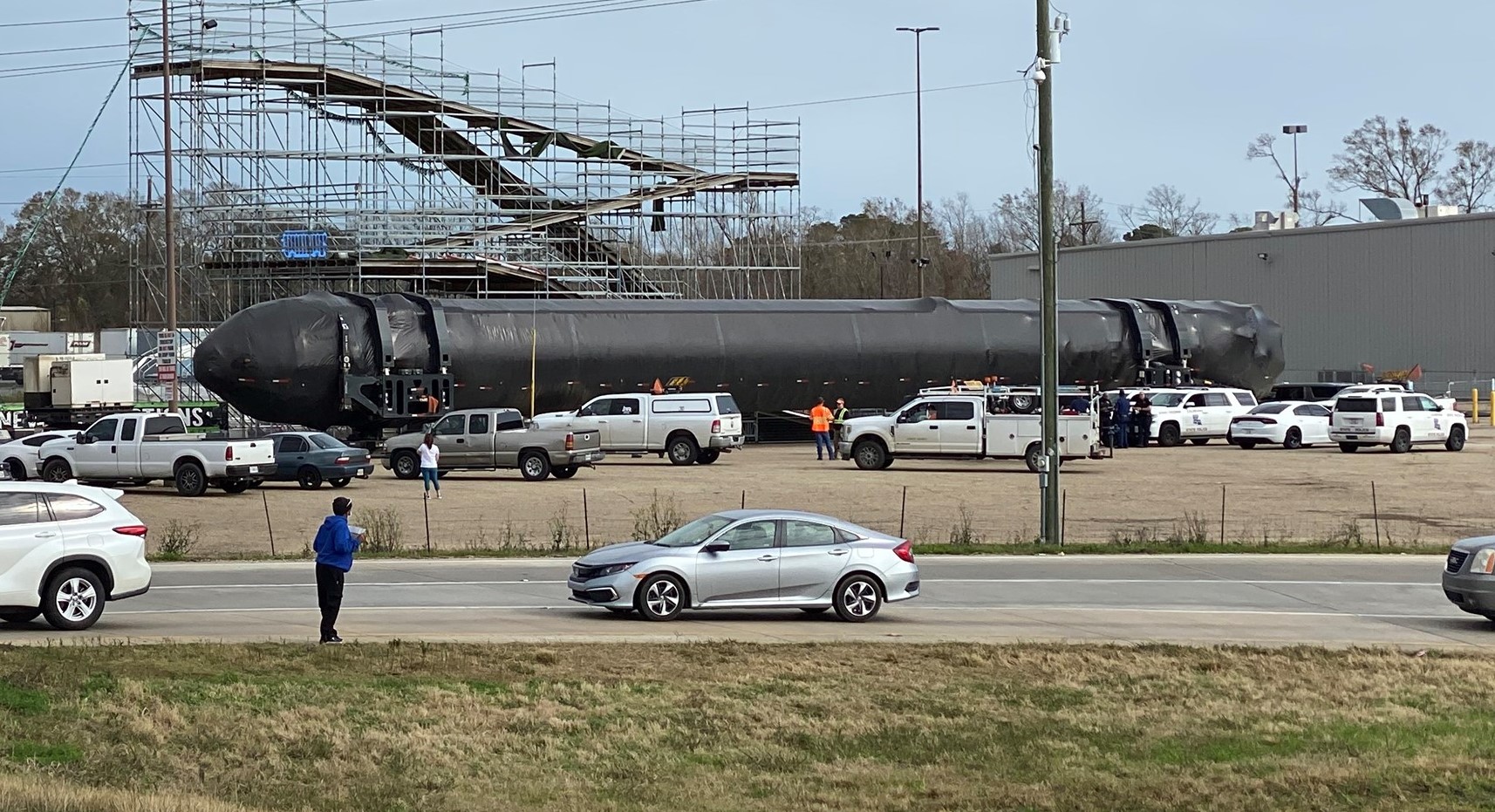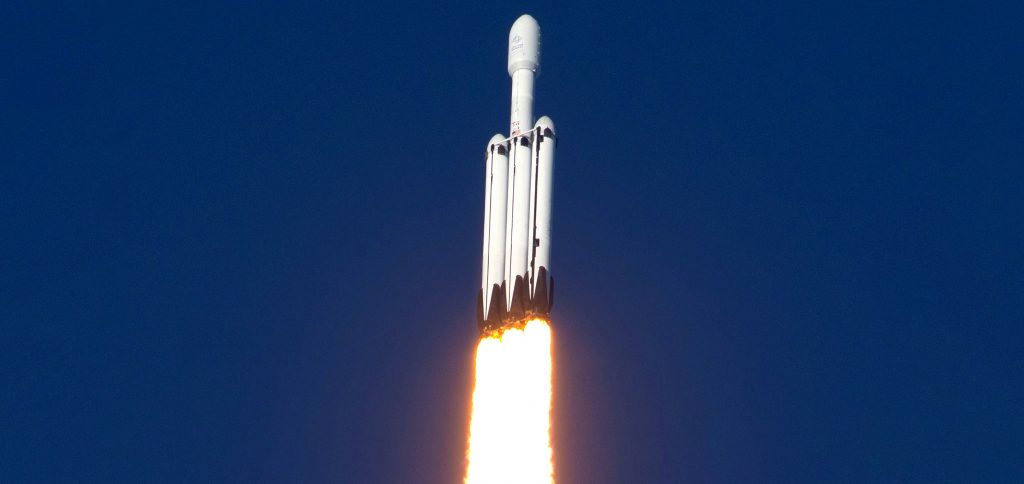

News
SpaceX begins Falcon Heavy booster deliveries for first launch in two years
SpaceX’s first Falcon Heavy rocket launch in almost two years has entered the final stages of preparations – flight hardware acceptance testing, delivery, and assembly.
Comprised of five major elements, the vast majority of the challenges of building and launching Falcon Heavy come from the rocket’s three first-stage boosters – each more or less equivalent to a single-core Falcon 9 booster. Falcon Heavy’s twin side boosters are by far the most visually recognizable sign of that similar-but-different nature thanks to the need for aerodynamic nosecones instead of a Falcon booster’s normal interstage (a hollow cylinder).
While easily recognizable, the center core is the most technically Falcon Heavy-specific part of SpaceX’s partially-reusable heavy-lift rocket, requiring a unique airframe relative to side cores, which are essentially Falcon 9 boosters with a few major add-ons. It’s one of those Falcon Heavy side boosters that was spotted traveling by road from SpaceX’s test facilities to a Florida launch pad on Tuesday, January 26th.
For unknown reasons, although SpaceX currently has two reused Falcon Heavy side boosters that flew a second time on the US Air Force’s own STP-2 mission, the company has manufactured all-new boosters – likely at the US military’s request – for the rocket’s fourth launch. Rebadged from AFSPC-44 to USSF-44, that mission will see SpaceX attempt its first-ever direct-to-GEO launch, nominally launching a several-ton mystery satellite directly into geostationary orbit (GEO).
The main challenge of direct-to-GEO launches is the need for a given rocket’s upper stage to coast for hours in orbit and then reignite after that multi-hour coast period. The direct launch profile also demands more delta-V (propellant) than alternative transfer orbits (GTOs) – propellant that must be launched into orbit in addition to the customer’s payload. That requires the use of extremely large and/or efficient rockets, which is why SpaceX is launching USSF-44 with Falcon Heavy instead of a much cheaper and simpler Falcon 9.

Unlike all other direct-to-GEO launches in history, however, Falcon Heavy Flight 4 will (hopefully) mark the first time a rocket launches a payload into geostationary orbit while still recovering a large portion of its first stage. After liftoff, Falcon Heavy side boosters B1064 and B1065 will attempt the first-ever dual drone ship landing at sea, while the rocket’s custom center core will be intentionally expended. According to CEO Elon Musk, that sacrificial-center-core configuration theoretically allows Falcon Heavy to achieve ~90% of its expendable performance while still recovering two otherwise reusable boosters.
As of the first USSF-44 side booster’s appearance in Louisiana, at least one other booster (most likely the mission’s second side booster) has already been spotted at SpaceX’s McGregor, Texas development facilities and may have already completed its own round of static fire acceptance testing. Given the three-month gap between the first USSF-44 side booster’s static fire and a side booster’s appearance in transport, there’s a distant possibility that the booster spotted on January 26th was the second of two side boosters to ship east, but that’s improbable given how much Falcon boosters stick out on the road.
Ultimately, assuming the second USSF-44 side booster’s static fire acceptance test went well, the only major Falcon Heavy-specific hardware SpaceX needs to ship from its Hawthorne, CA headquarters is center core B1066. An upper stage and payload fairing will also have to pass acceptance testing and head to Florida but both will likely be standard Falcon 9-issue hardware, minimizing small-batch uncertainty.
If SpaceX delivers B1066 to McGregor within the next week or two, the center core should be ready to ship to Florida by March or April, leaving SpaceX two or three months to integrate, static fire, and prepare Falcon Heavy for its fourth launch. According to the latest official information from the US military, USSF-44 is scheduled to launch no earlier than (NET) “late-spring 2021,” likely implying late-May or June.
Elon Musk
Tesla begins expanding Robotaxi access: here’s how you can ride
You can ride in a Tesla Robotaxi by heading to its website and filling out the interest form. The company is hand-picking some of those who have done this to gain access to the fleet.

Tesla has begun expanding Robotaxi access beyond the initial small group it offered rides to in late June, as it launched the driverless platform in Austin, Texas.
The small group of people enjoying the Robotaxi ride-hailing service is now growing, as several Austin-area residents are receiving invitations to test out the platform for themselves.
The first rides took place on June 22, and despite a very small number of very manageable and expected hiccups, Tesla Robotaxi was widely successful with its launch.
Tesla Robotaxi riders tout ‘smooth’ experience in first reviews of driverless service launch
However, Tesla is expanding the availability of the ride-hailing service to those living in Austin and its surrounding areas, hoping to gather more data and provide access to those who will utilize it on a daily basis.
Many of the people Tesla initially invited, including us, are not local to the Austin area.
There are a handful of people who are, but Tesla was evidently looking for more stable data collection, as many of those early invitees headed back to where they live.
The first handful of invitations in the second round of the Robotaxi platform’s Early Access Program are heading out to Austin locals:
I just got a @robotaxi invite! Super excited to go try the service out! pic.twitter.com/n9mN35KKFU
— Ethan McKanna (@ethanmckanna) July 1, 2025
Tesla likely saw an influx of data during the first week, as many traveled far and wide to say they were among the first to test the Robotaxi platform.
Now that the first week and a half of testing is over, Tesla is expanding invites to others. Many of those who have been chosen to gain access to the Robotaxi app and the ride-hailing service state that they simply filled out the interest form on the Robotaxi page of Tesla’s website.
That’s the easiest way you will also gain access, so be sure to fill out that form if you have any interest in riding in Robotaxi.
Tesla will continue to utilize data accumulated from these rides to enable more progress, and eventually, it will lead to even more people being able to hail rides from the driverless platform.
With more success, Tesla will start to phase out some of the Safety Monitors and Supervisors it is using to ensure things run smoothly. CEO Elon Musk said Tesla could start increasing the number of Robotaxis to monitors within the next couple of months.
Elon Musk
Tesla analyst issues stern warning to investors: forget Trump-Musk feud

A Tesla analyst today said that investors should not lose sight of what is truly important in the grand scheme of being a shareholder, and that any near-term drama between CEO Elon Musk and U.S. President Donald Trump should not outshine the progress made by the company.
Gene Munster of Deepwater Management said that Tesla’s progress in autonomy is a much larger influence and a significantly bigger part of the company’s story than any disagreement between political policies.
Munster appeared on CNBC‘s “Closing Bell” yesterday to reiterate this point:
“One thing that is critical for Tesla investors to remember is that what’s going on with the business, with autonomy, the progress that they’re making, albeit early, is much bigger than any feud that is going to happen week-to-week between the President and Elon. So, I understand the reaction, but ultimately, I think that cooler heads will prevail. If they don’t, autonomy is still coming, one way or the other.”
BREAKING: GENE MUNSTER SAYS — $TSLA AUTONOMY IS “MUCH BIGGER” THAN ANY FEUD 👀
He says robotaxis are coming regardless ! pic.twitter.com/ytpPcwUTFy
— TheSonOfWalkley (@TheSonOfWalkley) July 2, 2025
This is a point that other analysts like Dan Ives of Wedbush and Cathie Wood of ARK Invest also made yesterday.
On two occasions over the past month, Musk and President Trump have gotten involved in a very public disagreement over the “Big Beautiful Bill,” which officially passed through the Senate yesterday and is making its way to the House of Representatives.
Musk is upset with the spending in the bill, while President Trump continues to reiterate that the Tesla CEO is only frustrated with the removal of an “EV mandate,” which does not exist federally, nor is it something Musk has expressed any frustration with.
In fact, Musk has pushed back against keeping federal subsidies for EVs, as long as gas and oil subsidies are also removed.
Nevertheless, Ives and Wood both said yesterday that they believe the political hardship between Musk and President Trump will pass because both realize the world is a better place with them on the same team.
Munster’s perspective is that, even though Musk’s feud with President Trump could apply near-term pressure to the stock, the company’s progress in autonomy is an indication that, in the long term, Tesla is set up to succeed.
Tesla launched its Robotaxi platform in Austin on June 22 and is expanding access to more members of the public. Austin residents are now reporting that they have been invited to join the program.
Elon Musk
Tesla surges following better-than-expected delivery report
Tesla saw some positive momentum during trading hours as it reported its deliveries for Q2.

Tesla (NASDAQ: TSLA) surged over four percent on Wednesday morning after the company reported better-than-expected deliveries. It was nearly right on consensus estimations, as Wall Street predicted the company would deliver 385,000 cars in Q2.
Tesla reported that it delivered 384,122 vehicles in Q2. Many, including those inside the Tesla community, were anticipating deliveries in the 340,000 to 360,000 range, while Wall Street seemed to get it just right.
Tesla delivers 384,000 vehicles in Q2 2025, deploys 9.6 GWh in energy storage
Despite Tesla meeting consensus estimations, there were real concerns about what the company would report for Q2.
There were reportedly brief pauses in production at Gigafactory Texas during the quarter and the ramp of the new Model Y configuration across the globe were expected to provide headwinds for the EV maker during the quarter.
At noon on the East Coast, Tesla shares were up about 4.5 percent.
It is expected that Tesla will likely equal the number of deliveries it completed in both of the past two years.
It has hovered at the 1.8 million mark since 2023, and it seems it is right on pace to match that once again. Early last year, Tesla said that annual growth would be “notably lower” than expected due to its development of a new vehicle platform, which will enable more affordable models to be offered to the public.
These cars are expected to be unveiled at some point this year, as Tesla said they were “on track” to be produced in the first half of the year. Tesla has yet to unveil these vehicle designs to the public.
Dan Ives of Wedbush said in a note to investors this morning that the company’s rebound in China in June reflects good things to come, especially given the Model Y and its ramp across the world.
He also said that Musk’s commitment to the company and return from politics played a major role in the company’s performance in Q2:
“If Musk continues to lead and remain in the driver’s seat, we believe Tesla is on a path to an accelerated growth path over the coming years with deliveries expected to ramp in the back-half of 2025 following the Model Y refresh cycle.”
Ives maintained his $500 price target and the ‘Outperform’ rating he held on the stock:
“Tesla’s future is in many ways the brightest it’s ever been in our view given autonomous, FSD, robotics, and many other technology innovations now on the horizon with 90% of the valuation being driven by autonomous and robotics over the coming years but Musk needs to focus on driving Tesla and not putting his political views first. We maintain our OUTPERFORM and $500 PT.”
Moving forward, investors will look to see some gradual growth over the next few quarters. At worst, Tesla should look to match 2023 and 2024 full-year delivery figures, which could be beaten if the automaker can offer those affordable models by the end of the year.
-

 Elon Musk2 days ago
Elon Musk2 days agoTesla investors will be shocked by Jim Cramer’s latest assessment
-

 News1 week ago
News1 week agoTesla Robotaxi’s biggest challenge seems to be this one thing
-

 Elon Musk2 weeks ago
Elon Musk2 weeks agoElon Musk slams Bloomberg’s shocking xAI cash burn claims
-

 News2 weeks ago
News2 weeks agoTexas lawmakers urge Tesla to delay Austin robotaxi launch to September
-

 Elon Musk1 week ago
Elon Musk1 week agoFirst Look at Tesla’s Robotaxi App: features, design, and more
-

 Elon Musk2 weeks ago
Elon Musk2 weeks agoTesla Robotaxis are becoming a common sight on Austin’s public roads
-

 Elon Musk2 weeks ago
Elon Musk2 weeks agoxAI’s Grok 3 partners with Oracle Cloud for corporate AI innovation
-

 Elon Musk2 weeks ago
Elon Musk2 weeks agoSpaceX President meets India Minister after Starlink approval

















